- GENERAL
| SCHOOL | SOCIAL POLITICAL AND ECONOMIC SCIENCES | ||||
| DEPARTMENT | SOCIAL POLICY | ||||
| LEVEL OF STUDIES | LEVEL 6 | ||||
| COURSE CODE | 61 | SEMESTER | 6th and 8th | ||
| COURSE TITLE | Economics of Social Security | ||||
| TEACHING ACTIVITIES If the ECTS Credits are distributed in distinct parts of the course e.g.lectures, labs etc. If the ECTS Credits are awarded to the whole course, then please indicate the teaching hours per week and the corresponding ECTS Credits. |
TEACHING HOURS PER WEEK | ECTS CREDITS | |||
| 3 | 6 | ||||
| Please, add lines if necessary.Teaching methods and organization of the course are described in section 4. | |||||
| COURSE TYPE
Background, GeneralKnowledge, Scientific Area, Skill Development |
Scientific Area | ||||
| PREREQUISITES: | NO | ||||
| TEACHING & EXAMINATION LANGUAGE: | GREEK | ||||
| COURSE OFFERED TO ERASMUSSTUDENTS: | ΝΟ | ||||
| COURSE URL: | https://eclass.duth.gr/courses/KOM09118/ | ||||
- LEARNING OUTCOMES
| Learning Outcomes | |
| Please describe the learning outcomes of the course: Knowledge, skills and abilities acquired after the successful completion of the course. | |
| In this course presented and analysed are the economic dimensions of the social security system with help from tools of modern economics. These economic dimensions, as reflected in certain indicators, are crucial in achieving and assessing the distributional objectives of the system, as well as its effectiveness in the administration of the available resources. The course also provides a comparative review of the key features of the social security system in Greece and internationally. It highlights similarities and differences between systems internationally in terms of funding, benefits and distributive effects. The system is analysed macro-economically and micro-economically. Within context is also investigated, historically and theoretically, the impact of social security system on economic growth. Particular emphasis is given to mapping and analysing the perspectives of the Greek social security system under the influence of contemporary demographic and economic trends. The aim of this course is for students to understand the economic dimensions and functions of the social security system and its challenges and opportunities in light of the social and economic developments.
Upon completion of the course students should be able to:
|
|
| General Skills | |
| Name the desirable general skills upon successful completion of the module | |
| Search, analysis and synthesis of data and information,
ICT Use Adaptation to new situations Decision making Autonomous work Teamwork Working in an international environment Working in an interdisciplinary environment Production of new research ideas |
Project design and management
Equity and Inclusion Respect for the natural environment Sustainability Demonstration of social, professional and moral responsibility and sensitivity to gender issues Critical thinking Promoting free, creative and inductive reasoning |
| Search, analysis and synthesis of data and information,
ICT Use Adaptation to new situations Decision making Equity and Inclusion Respect for the natural environment Sustainability Autonomous work Critical thinking Promoting free, creative and inductive reasoning |
|
- COURSE CONTENT
|
- LEARNING & TEACHING METHODS – EVALUATION
| TEACHING METHOD Face to face, Distance learning, etc. |
Face to face | ||||||||||||||
| USE OF INFORMATION & COMMUNICATIONS TECHNOLOGY (ICT) Use of ICT in Teaching, in Laboratory Education, in Communication with students |
1. Use of power point during lectures.
2. Posting of teaching material, bibliography, slides, exercises, notes, outline and evaluation methods of the course on e-class. 3. Use of brainstorming, creation of working groups during lectures.
|
||||||||||||||
| TEACHING ORGANIZATION
The ways and methods of teaching are described in detail. Lectures, Seminars, Laboratory Exercise, Field Exercise, Bibliographicresearch& analysis, Tutoring, Internship (Placement), Clinical Exercise, Art Workshop, Interactive learning, Study visits, Study / creation, project, creation, project. Etc. The supervised and unsupervised workload per activity is indicated here, so that total workload per semester complies to ECTS standards. |
|
||||||||||||||
| Student Evaluation
Description of the evaluation process Assessment Language, Assessment Methods, Formative or Concluding, Multiple Choice Test, Short Answer Questions, Essay Development Questions, Problem Solving, Written Assignment, Essay / Report, Oral Exam, Presentation in audience, Laboratory Report,Clinical examination of a patient,Artistic interpretation, Other/Others Please indicate all relevant information about the course assessment and how students are informed |
A written assignment (course work) and its public presentation, with simultaneous oral examination (100%).
|
- SUGGESTED BIBLIOGRAPHY
Compulsory
Optional
|
 Ο Πρόεδρος και τα μέλη του Διδακτικού Προσωπικού καλωσορίζουν τους νεοεισαχθέντες φοιτητές του Τμήματος.
Ο Πρόεδρος και τα μέλη του Διδακτικού Προσωπικού καλωσορίζουν τους νεοεισαχθέντες φοιτητές του Τμήματος.
